![]() Rheology of partial melted rocks
Rheology of partial melted rocks
![]() Concept of melt enhanced embrittlement
Concept of melt enhanced embrittlement
![]() Dihedral angle and melt segregation
Dihedral angle and melt segregation
![]() Achieving connected melt network by deformational processes
Achieving connected melt network by deformational processes
![]() Literature related to these topics
Literature related to these topics
|
| First suggestions about the implication of partial melt on rock rheology were made by Arzi (1978) using the Einstein- |
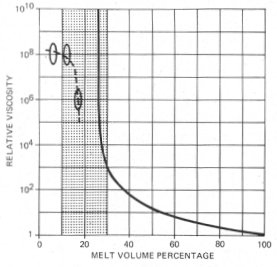 Graphical expression of the Einstein- |
 Concept of melt enhanced embrittlement
Concept of melt enhanced embrittlement| Pore fluids in soil or porous rocks contribute to the load that these rocks have to suffer by sustaining a certain amount of the stress field due to their incompressibility. Thus pore fluids have a major impact on rock strength by decreasing the normal stresses in a certain stress field by the amount of the pore stresses. Transferring this concept into the deep crust with partial molten rocks the melt acts as a pore fluid similar to the process described above. Applying this idea in a Mohr-Coulomb the differential stress expressed as a Mohr circle is moving towards the failure envelope. When reaching this envelope the rock fails in a typical manner. Davidson et al. (1992) developed this idea to explain extensional und shear fractures in a anatectic migmatite. |  Schematic evolution of a melt enhanced embrittlement by increasing melt pressure thus decreasing total strength. When the Mohr circle reaches the failure envelope the rock will fail. |
 Dihedral angle and melt segregation
Dihedral angle and melt segregation| Segregation of melt is not as easy as primarly thought to be. For a simple gravity forced segregation model due to 5-10 % lower density of the melt the formation of larger granitic bodies would take aprox. 1000 M.a. which is in fact not very realistic. But what processes drive the melt to segregate and form at least granitoids in the appropriate time ? To solve this we first have to discuss the geometry of initial melt inclusions. When melting starts the liquid phase is first formed at the edges of mineral grains. The configuration is determined by grain boundary energies both between the grains and between the melt and the grains which are functions of the surface tensions. This tension is expressed by the dihedral angle between melt and crystalline solids (see fig). From experimental studies one knows that basaltic melts have dihedral angles less than 60° allowing to form a continuous interconnection and flow of melt at very low melt fractions. Granitic melts have angles greater than 60° thus forming more or less isolated pools without a interconnection at the same melt fraction. Therefor it is difficult for melt to escape unless there is a certain porosity or a substantial amount of partila melting. Few models have been developed such as volumetric, gravitational or differential pressure gradients. We investigate the role of deformational processes for effective segregation |
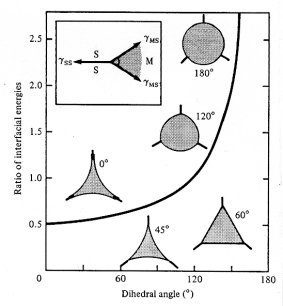 Relationsship between dihedral angle and the ratio of interfacial energies between melt and crytalline solids (in Brown et al., 1992) 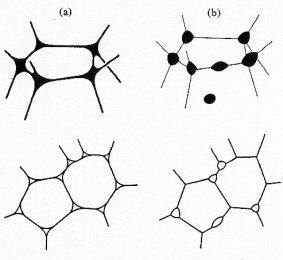 3-D distribution of melt around grain boundaries for (a) dihedral angles less than 60° and (b) greater than 60°. Note that for small dihedral angles there is a continuous interconnected network of melt (in Brown et al., 1992). |
 Achieving connected melt network by deformational processes
Achieving connected melt network by deformational processes| A major contribution to the deformation of two phase aggregates was done by Grujic & Mancktelow (1998) building a model with two materials of different rheological strengths. The model consists of a number of cylindrical weak inclusions in a matrix of wax acting as a stronger constituent. By deforming this model with constant strain rate and pure shear deformation concentrates in the weak inclusions while the wax in many areas stays remarkably undeformed. The former cylindrical inclusions align to more elliptical shape and finanlly forms connections between each other initiating a network of shear zones. Thus deformation of weaker inclusions like melt pools in a stronger matrix (grains) may lead to a interconnection allowing the melt to segregate along shear zones independently of scale to be referred to. | 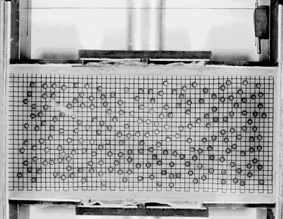 Two phase model consisting of weak cylindrical inclusions in a stronger wax matrix. Approx. random distribution of the inclusions prior to deformation. 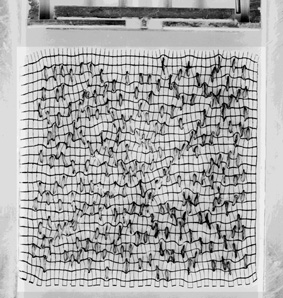 Deformation concentrates in weak inclusions leading to a interconnected network along shear zones. |
 Literature related to these topics
Literature related to these topics